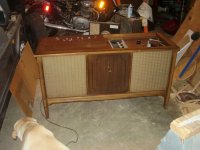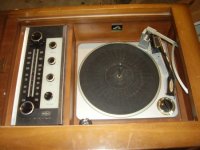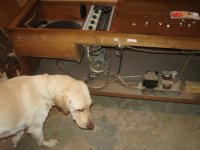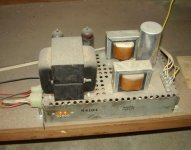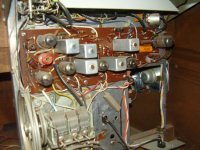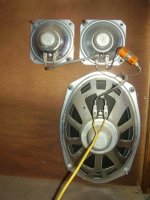...film at 11.
Here is proof that even a blind squirrel eventually finds a nut. I had made it known on the freecycle boards that I was always interested in old audio equipment. I was contacted by a young lady that wanted to get rid of a record player console. So Nan and I had lunch out after church today and then stopped by for a look see.
It didn't look like all that much and they knew nothing about it except that they had paid $75 for it a few months ago at an antique shop down the road. They said that it worked but had recently developed a "crackle" in one speaker. We turned it on and listened to it for a minute or two on the radio setting. It actually sounded pretty decent with no hint of the tinniness one often hears from such units. In fact it sounded a little bit light on the top end. I also noted no crackling.
Here is proof that even a blind squirrel eventually finds a nut. I had made it known on the freecycle boards that I was always interested in old audio equipment. I was contacted by a young lady that wanted to get rid of a record player console. So Nan and I had lunch out after church today and then stopped by for a look see.
It didn't look like all that much and they knew nothing about it except that they had paid $75 for it a few months ago at an antique shop down the road. They said that it worked but had recently developed a "crackle" in one speaker. We turned it on and listened to it for a minute or two on the radio setting. It actually sounded pretty decent with no hint of the tinniness one often hears from such units. In fact it sounded a little bit light on the top end. I also noted no crackling.
Attachments
Even though it was probably solid state, I figured that since it was free I might as well take it as I could always use the speakers and switches etc as salvage so we loaded it up and headed home.
Now I should have had a clue that something was afoot when he turned it on and we didn't get sound right away. However, he was fiddling with the tuner at the time so we may not have been on a station. When we finished it was tuned to a station that I knew that we could get at home.
Now I should have had a clue that something was afoot when he turned it on and we didn't get sound right away. However, he was fiddling with the tuner at the time so we may not have been on a station. When we finished it was tuned to a station that I knew that we could get at home.
Attachments
When we got home I took it into the garage and plugged it in. Again it didn't come on right away. Hmmm... It did come to life in a minute or so and so I left it run while I got Nan out of the car. After a few minutes I started to hear some crackling so I turned it off. It faded away gradually. Hmmm... again. Now I am starting to get suspicious.
So I began removing the back cover. I saw a glint of something. I quickened the pace and got the top and side screws out pulling the back gently out when what to my wondering eyes should appear but a pair of small bottles and a big silver can cap. And what is this? Too many transformers for a cheap old solid state console.
So I began removing the back cover. I saw a glint of something. I quickened the pace and got the top and side screws out pulling the back gently out when what to my wondering eyes should appear but a pair of small bottles and a big silver can cap. And what is this? Too many transformers for a cheap old solid state console.
Attachments
I may be preaching to the converted, but find a schematic and crossreference values original vs measured?
Do the usual, check connections etc. Does your Multimeter have capacitance readout?
Do the usual, check connections etc. Does your Multimeter have capacitance readout?
Will be searching but I will trace by hand if needed. Recapping is a given of course. One correction that last tube should be 6C9 not 6C3.
mike
mike
Sounds like duff connection/cap somewhere if it's crackling. Broken down electrolyte produces such noise
BTW searching for RCA VFR19M yielded very little so if anyone runs across a schematic...
Tracing will get pretty involved when it comes to the tuner chassis.
mike
Tracing will get pretty involved when it comes to the tuner chassis.
mike
Thanks Porkchop that is great! What an interesting circuit. It looks like they used a large enough plate resistor on the 12AX7 to make it reasonably linear so that is good.
But what is going on with that output stage? Is that some sort of UL connection? The connection to the screen is coming off of the end of the winding rather than in the middle. ??? Or is it just some funky way of getting screen voltage for pentode mode. Pentode mode seems unlikely since there is no feedback loop.
And the two channels share the cathode bias resistor??? Is that kind of thing common? In general a bit more complicated than I expected. 1965... that explains the liberal use of PCBs.
mike
But what is going on with that output stage? Is that some sort of UL connection? The connection to the screen is coming off of the end of the winding rather than in the middle. ??? Or is it just some funky way of getting screen voltage for pentode mode. Pentode mode seems unlikely since there is no feedback loop.
And the two channels share the cathode bias resistor??? Is that kind of thing common? In general a bit more complicated than I expected. 1965... that explains the liberal use of PCBs.
mike
Single ended 6BQ5 amps are wonderful pieces of kit. Nice score on your find!
I like the Yamaha in the background of the first shot. It looks like a late 70's or early 80's Special. I used to ride an '82 Eleven. I sure miss that bike...
SE 6BQ5 Eleven
Shared cathode bias isn't all that uncommon. Probably made the thing a nickel cheaper to manufacture. The common bias resistor is the pale blue cemented thing on the center left labeled "80".
Shared cathode bias Schematic
I like the Yamaha in the background of the first shot. It looks like a late 70's or early 80's Special. I used to ride an '82 Eleven. I sure miss that bike...
SE 6BQ5 Eleven
Shared cathode bias isn't all that uncommon. Probably made the thing a nickel cheaper to manufacture. The common bias resistor is the pale blue cemented thing on the center left labeled "80".
Shared cathode bias Schematic
Yep early 80s Heritage Special. A sad story really. A guy let it sit for two years with gas in it because he couldn't get it started. No spark. Several shops had a go at it and a couple of his buddies. 15 minutes with a circuit diagram and I had it sparking (pulled the side stand relay which was faulty). Unfortunately the carb dash post were now frozen in place (carb rebuild), clutch was also stuck and someone just decided to yank on the lever anyway and broke the fiber clutch actuator in the chain guard housing. So it will end up going to someone more equiped to fix the rest of the problems.
It would have been such an easy fix if only someone with a little reasoning power had gotten to it in a timely fashion.
mike
It would have been such an easy fix if only someone with a little reasoning power had gotten to it in a timely fashion.

mike
I have been studying the schematic that you sent me and it is quite interesting.
Aside from the interesting output stage they use a voltage doubler using high voltage silicon diodes into an RCRC network (100ohm,100uF,1.6K [or maybe 1.8K],80uF). There is apparently no provision for soft start so the plates are hit with the full 300V with cold cathodes. Ouch.
I sim'ed the PS with the Duncan amp tool assuming 80mA drawn by the output tubes and it appears to provide approximately the stated voltage with only about 1V p-p ripple. That is lower than I had expected with such a simple filter but those are pretty big caps.
I wonder why they went with a doubler seeing as they were putting in a PT anyway. Would the extra cap be cheaper than the extra windings in the PT? Or do the caps on the double provide "free" filtering?
As to the radio sections that is way over my head. Need a copy of radio receivers for dummies I guess. It looks like the am side has an RF amplifier and then a heptode for the converter whose output appears to be fed both to the selector switch and to other circuits (AM Det etc) V203 and V204.
I am running a test tonight after sundown to see if this AM tuner is any better than the others that I have on hand. I may not understand the circuitry but I can tell if it works. 😉
mike
Aside from the interesting output stage they use a voltage doubler using high voltage silicon diodes into an RCRC network (100ohm,100uF,1.6K [or maybe 1.8K],80uF). There is apparently no provision for soft start so the plates are hit with the full 300V with cold cathodes. Ouch.
I sim'ed the PS with the Duncan amp tool assuming 80mA drawn by the output tubes and it appears to provide approximately the stated voltage with only about 1V p-p ripple. That is lower than I had expected with such a simple filter but those are pretty big caps.
I wonder why they went with a doubler seeing as they were putting in a PT anyway. Would the extra cap be cheaper than the extra windings in the PT? Or do the caps on the double provide "free" filtering?
As to the radio sections that is way over my head. Need a copy of radio receivers for dummies I guess. It looks like the am side has an RF amplifier and then a heptode for the converter whose output appears to be fed both to the selector switch and to other circuits (AM Det etc) V203 and V204.
I am running a test tonight after sundown to see if this AM tuner is any better than the others that I have on hand. I may not understand the circuitry but I can tell if it works. 😉
mike
Watch out for bad AFC switch
I appreciate this thread and having finally found a schematic for this FM/AM tuner.
If you have trouble with your FM tuner drifting I found the push/pull AFC switch defective on my unit. ( same as in the pictures in this thread.)
AFC is automatic frequency control and it completes a feedback loom to keep your FM locked to the station you dial too. Normally you want to turn it off while you are tuning in another station so that it does not try to keep the current one locked. Then when you tune in the new station you turn AFC back on. This unit has a four terminal switch.. on a pushpull shaft on the balance control. It has two SPST switches wired up to be DPST. These types of switches are notorious over the years where the pot metal rocker arm inside breaks. We use to buy switches and remount on the back of the balance control potentiometer. Or we would take apart other swtiches and transfer a good pot metal arm into the defective switch and put it back together. However, for this unit I just mounted a SPDT toggle switch on the front panel and all is great!
I appreciate this thread and having finally found a schematic for this FM/AM tuner.
If you have trouble with your FM tuner drifting I found the push/pull AFC switch defective on my unit. ( same as in the pictures in this thread.)
AFC is automatic frequency control and it completes a feedback loom to keep your FM locked to the station you dial too. Normally you want to turn it off while you are tuning in another station so that it does not try to keep the current one locked. Then when you tune in the new station you turn AFC back on. This unit has a four terminal switch.. on a pushpull shaft on the balance control. It has two SPST switches wired up to be DPST. These types of switches are notorious over the years where the pot metal rocker arm inside breaks. We use to buy switches and remount on the back of the balance control potentiometer. Or we would take apart other swtiches and transfer a good pot metal arm into the defective switch and put it back together. However, for this unit I just mounted a SPDT toggle switch on the front panel and all is great!
I still don't get the brown screen tap on the OPTs???
Why is it wound as-if for bootstrap rather than UL?
Assuming the bypass cap wasn't there and screens
weren't also tied together...
Heck, if not for the 3K9 screen resistors, that might
be a shorted turn (capacitively right through C401).
Why parasitically load the OPTs in this manner?
Nowhere near enough DC here to buck saturation.
Its just weird... RCA must have had a legitimate
reason, I'm not getting it. Its just weird...
Why is it wound as-if for bootstrap rather than UL?
Assuming the bypass cap wasn't there and screens
weren't also tied together...
Heck, if not for the 3K9 screen resistors, that might
be a shorted turn (capacitively right through C401).
Why parasitically load the OPTs in this manner?
Nowhere near enough DC here to buck saturation.
Its just weird... RCA must have had a legitimate
reason, I'm not getting it. Its just weird...
Here is my uneducated WAG. The OPT's are far larger than the usual SE OPT found in a console. Maybe they were left over from another design and weren't gapped for SE use. The color code does match a Schumaker P-P OPT. The 606 on the transformer makes it a Schumaker. I have used Schumaker P-P OPT's quite successfully in a SE amp, although I was using an "80VA" guitar amp OPT in a 3 watt amp.
The 40 uF cap from the screen grid to ground makes it a pentode amp, but the big resistor effectively across a piece of the OPT winding is eating output power for lunch. It also improves the pentode damping factor so that the feedback can be left out.
The 40 uF cap from the screen grid to ground makes it a pentode amp, but the big resistor effectively across a piece of the OPT winding is eating output power for lunch. It also improves the pentode damping factor so that the feedback can be left out.
The way the OPT is wired is interesting... i've recycled quite a few like this, and at least one very close to the same... i never bothered tracing the wiring, just pulling them apart... i measured many an OPT that had (what i thot was) a 20% UL tap... i'll have to dig into the maps i have and see if any of them follow this colour scheme.
dave
dave
- Status
- Not open for further replies.
- Home
- Amplifiers
- Tubes / Valves
- Extry, Extry, Blind Squirrel Finds Nut -sequence
